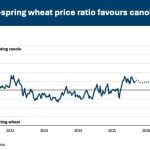Crop futures markets have gone flat in recent weeks, but analysts say that’s better than it could be.
Futures markets are being propped up by a lack of surprising news, which destabilize markets, and a steady stream of money invested in commodities.
“The constant demand from the more speculative crowd is underpinning that market more than the fundamentals might suggest,” said Informa Economics analyst David Reimann about the relative strength of wheat in the face of a huge world crop. “Investment money coming in has influenced that market to some degree.”
Read Also

Farmers urged to be grain-safe this fall
Working around grain bins comes with risk, from farmers falling to drowning in grain: Experts have five tips to help avoid grain-related accidents this harvest.
In recent weeks, futures prices for canola, soybeans and corn have settled in fairly narrow trading ranges without trending higher or lower, following a rally that began in early October.
Canola is steady even though Canadian canola exports to China are severely restricted because of blackleg fears and canola meal shipments to the United States have been held up because of salmonella contamination.
Soybeans had the strongest support, thanks to large U.S. exports.
The wheat market is the weakest of the bunch and has fallen in the last two weeks but is still above where it was priced in late October.
Wheat has problems with huge world stocks and slow U.S. wheat exports. Last week’s U.S. Department of Agriculture supply and demand report offered no reason for wheat, corn and soybean markets to rally. It reported both crops as within expectations. It reported lower soybean year end stocks, but not as much as traders expected.
Reimann said the USDA report was unsurprising, and there is little market-moving news, with northern hemisphere crops in the bin and southern ones just underway.
“There’s not a lot of fresh, fundamental bad news that you can throw at the market right now,” said Reimann.
Many analysts attribute the strength of the market to non-commercial, investment money moving into agricultural commodities. Since the rebound of the stock markets in March, speculative money has moved away from low risk money market funds and into stock markets and commodities. Oil and gold have recovered from their March lows and recently speculative money has returned to the crop markets.
That trend is being driven by views like those of investment adviser Jim Rogers, who told Bloomberg News recently that he thinks commodities are a better investment than stocks in the unsettled world economy.
“If the world’s economy is going to get better, commodities are the place to be because there are shortages developing,” said Rogers.
“If the world economy is not going to get better, you’re not going to make any money on stocks but your commodities are still a good place to be because they’re printing so much money.”
The question for many is whether there is a risk that the speculative money will pull out and deflate the market, or whether money will continue to pour in and boost prices beyond where supply and demand would justify.
Reimann said he thinks the situation could be short-term bearish, medium-term bullish.
“It depends on the time frame,” said Reimann, anticipating a downward correction after the recent rally.
“But we don’t have the same massive positions (of speculative money) we did 18 months ago.”
Investor desire to keep money out of stock markets and to avoid over investing in mega-commodities such as oil and gold will likely create sustainable demand for agricultural commodities, so long as the world’s economy continues to recover, he said.















